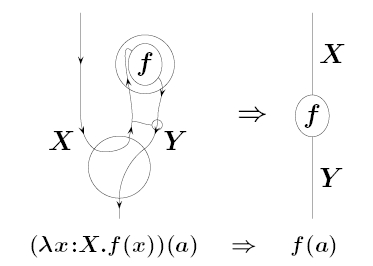New Structures for Physics III
Posted by John Baez
Here’s a new improved version of a paper for Bob Coecke’s book New Structures for Physics:
- John Baez and Mike Stay, Physics, topology, logic and computation: a Rosetta Stone — 4th draft version or arXiv version.
We thought it was done almost a year ago, but there was a serious mistake at the very end of the section on computation. Now we’ve completely rewritten that section — so, we’d love to hear what you think about it. Typos? Fine, we’ll fix them. Serious mistakes? I hope not, but if so, please tell us about them now!
The mistake, in case you’re wondering, was in our discussion of a programming language that was supposed to perfectly reflect what you can do in a symmetric monoidal closed category. Luckily, we found that Simon Ambler had invented such a language in his thesis:
- Simon Ambler, First order linear logic in symmetric monoidal closed categories, Ph.D. thesis, U. of Edinburgh, 1991. Also available in gzipped Postscript from his homepage.
So, we decided to explain that! This required massive revisions of the whole ‘computation’ section of our paper.
Luckily, we had a year to do this. That’s because another person writing a paper for Bob’s book was also late. When he finished his contribution, we had to hurry up and finish ours.
I don’t want to name names, but this other person’s paper is really great:
-
Peter Selinger, A survey of graphical languages for monoidal categories.
Abstract: This article is intended as a reference guide to various notions of monoidal categories and their associated string diagrams. It is hoped that this will be useful not just to mathematicians, but also to physicists, computer scientists, and others who use diagrammatic reasoning. We have opted for a somewhat informal treatment of topological notions, and have omitted most proofs. Nevertheless, the exposition is sufficiently detailed to make it clear what is presently known, and to serve as a starting place for more in-depth study. Where possible, we provide pointers to more rigorous treatments in the literature. Where we include results that have only been proved in special cases, we indicate this in the form of caveats.
It nicely complements our paper and also this one by Coecke and Paquette, which will appear in the same book:
- Bob Coecke and Eric Oliver Paquette, Categories for the practicing physicist.
All three papers tackle the theme of ‘string diagrams’ as tools for reasoning in monoidal categories — but they take quite different angles. Together they cover the subject pretty thoroughly.



Re: New Structures for Physics III
Quibble:
At the bottom of page 9, you say that only topology matters. I think what you mean is that only the relative order of the critical points matters. Latter with the tensorator, you might relax this condition. But right now, the tangles are going to be composed of cups caps, tensor products, and “straight” strings.